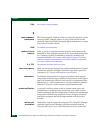
Glossary
g-39
Glossary
OSI See Open Systems Architecture.
OSMS See open systems management server.
out-of-band
management
Transmission of management information, using frequencies or chan-
nels other than those routinely used for information transfer.
P
packet In Fibre Channel protocol, Logical unit of information (usually in the
form of a data frame) transmitted on a network. It contains a header
(with all relevant addressing and timing information), the actual data,
and a trailer (which contains the error checking function, usually in
the form of a cyclic redundancy check), and frequently user data.
panel A logical component of the interface window. Typically, a heading
and/or frame marks the panel as an individual entity of the window.
Size and shape of the panel and its data depend upon the purpose of
the panel and may or may not be modified.
PC See personal computer.
persistent binding A form of server-level access control that uses configuration informa-
tion to bind a server to a specific Fibre Channel storage volume (or
logical device), using a unit number. See also access control.
personal computer PC. A portable computer that consists of a system unit, display, key-
board, mouse, one or more diskette drives, and internal fixed-disk
storage (D).
point-to-point A Fibre Channel protocol topology that provides a single, direct con-
nection between two communication ports. The director or switch
supports only point-to-point topology.
port Receptacle on a device to which a cable leading to another device can
be attached. Ports provide Fibre Channel connections (D).
port address name A user-defined symbolic name of 24 characters or less that identifies a
particular port address.
port authorization Feature of the password definition function that allows an adminis-
trator to extend operator-level passwords to specific port addresses


















